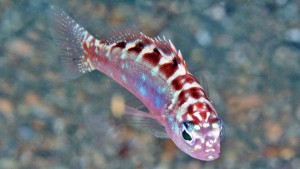Anyone who has visited Saltwater Smarts on a regular basis knows that Chris has a bizarre fixation on Caribbean species. No livestock—fish or invertebrate—originating outside the Caribbean/tropical Western Atlantic is allowed in his tank. If he could, he’d probably go so far as to encase his entire fish room in a plastic bubble and pump Caribbean air into it to prevent non-Caribbean airborne microbes from settling in his tank. It’s a disease, really, and he should probably seek treatment for it.
Nonetheless, in some cases, Chris’s compulsion is well justified. Take, for example, the chalk bass (Serranus tortugarum) that grace his tank. These little Caribbean jewels are gorgeous, peaceful, hardy, easy to feed, beginner friendly, and well-suited to modest-sized marine systems. Oh, and did I mention they can be kept in groups? What more could you ask for in a marine fish?
Physical traits
S. tortugarum has a torpedo-shaped body and sports alternating vertical bands of orange and light blue. Also, along each flank, originating approximately at the lateral line and extending downward, is a stunning opalescent sheen that really pops under certain lighting schemes. The maximum length for the chalk bass is only about 3 inches.
Feeding
This Serranid (family Serranidae) is a zooplanktivore that will usually learn to accept a wide variety of small meaty food items, such as mysid shrimp, chopped mollusk and crustacean flesh, frozen formulations for small carnivores, as well as dry pellets/flakes.
Housing
As I mentioned above, S. tortugarum is a terrific candidate for modest-sized systems. I would consider a standard 29-gallon tank to be minimum housing for this species, though if you want to keep a small group—say, five specimens or so—you might want to go larger. Also, chalk bass can be shy when first introduced, so the rockwork should be arranged to provide ample hiding places. A cover to prevent jumping is essential as well.
Compatibility
S. tortugarum is typically peaceful and inoffensive toward other species, so any relatively small, non-aggressive fishes will make suitable tankmates. Of course, any piscivorous species capable of swallowing a chalk bass, such as lionfish and groupers, should be excluded. (Sorry, Chris! You’ll just have to forego that goliath grouper you’ve had your eye on!) If you plan to keep a group, be sure to add all the specimens at the same time.
With respect to reef-safeness, you can’t do much better than S. tortugarum. This little Serranid is completely harmless to sessile invertebrates and to all but the very smallest motile invertebrates.



